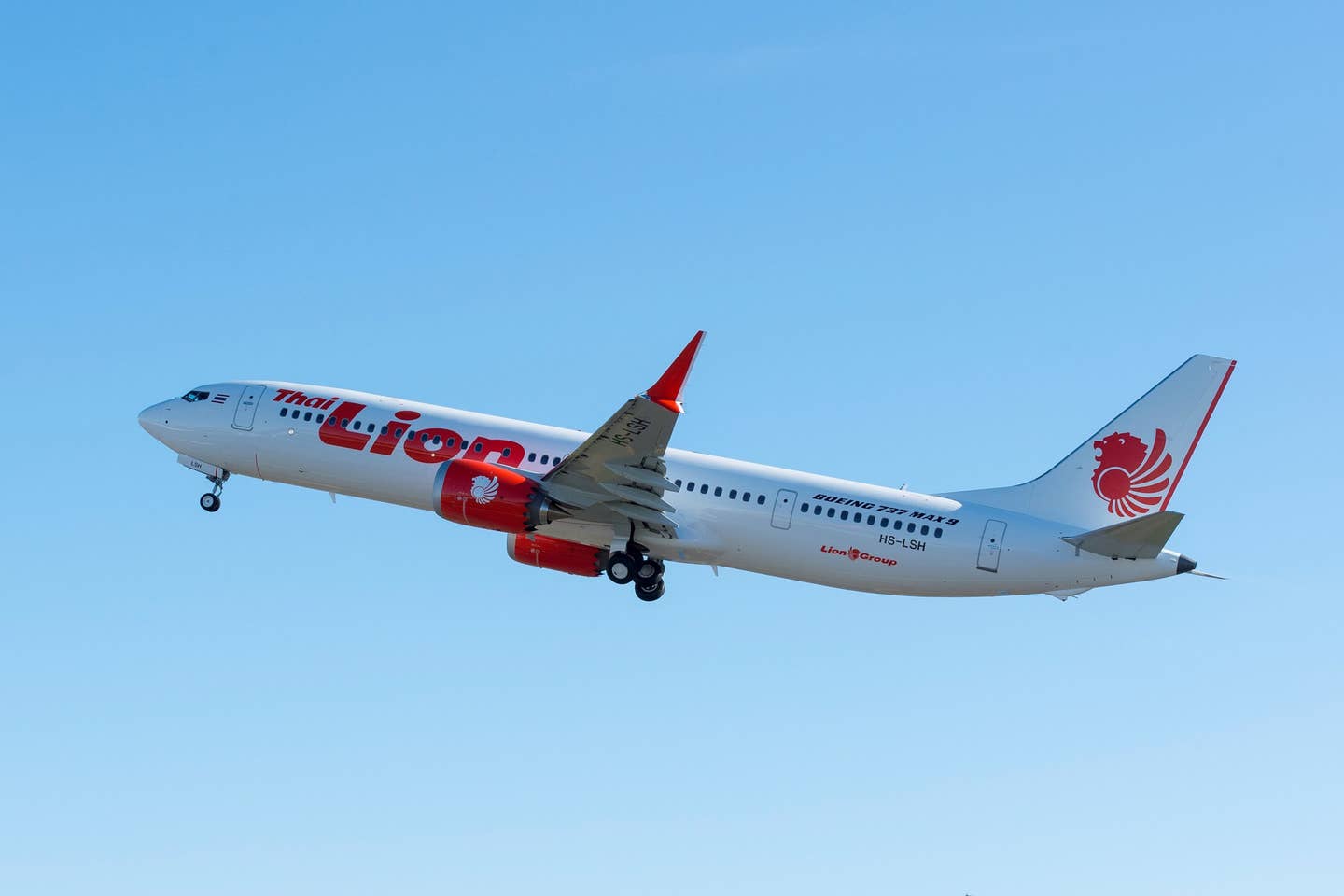
Boeing’s 737-8 Max remains grounded one year after the crash of Lion Air 610. Boeing
Aviators understand that aircraft accidents seldom occur because of a single misstep in the human or technological chain. They usually occur when a flight crew is overwhelmed by multiple human or technological failures within a short time span.
The Komite Nasional Keselamatan Transportasi of Indonesia, also known as the National Transportation Safety Committee (NTSC), issued its final report of the crash of Lion Air flight 610, a Boeing 737 Max, published almost one year to the date after the October 29, 2018, accident. The NTSC identified more than just a few factors that combined to bring the aircraft down in the Java Sea with the loss of all 189 people aboard.
With news coverage of the Max over the past year, it would be easy to point to the well-documented institutional failures at both Boeing and the FAA to explain what happened, but when the NTSC report is tied together with the NTSB report last month that detailed lapses in judgement at Boeing as the Max was developed, the report becomes even more damning. The NTSC also looked closely at the role of Lion Air personnel in the accident.
The NTSC’s 322-page accident report looks at the now infamous Maneuvering Characteristics Augmentation System on the 737 Max as the primary culprit, but with a host of contributing issues. The MCAS software was, for instance, actually triggered by faulty data being fed from a misaligned angle of attack indicator installed just before the accident flight by Lion Air maintenance, handled by Batam Aero Technic and a repair facility, Xtra Aerospace LLC.
The pilots of flight 610 were also faulted in the report. During the takeoff roll, the 737’s digital flight data recorder indicated a 21-degree difference between the captain’s and the first officer’s angle of attack (AoA) indicator, that the crew failed to notice. They also did not notice that the captain’s PFD showed a pitch attitude of -1 degree while the FO’s showed +13. Another weak spot was coordination between the two Lion Air pilots immediately after takeoff. The first officer tried to communicate with the captain early on but received no response. A few moments later the captain did not receive a response from the FO as he gave him instructions to try and manage the emergency. In the crew’s defense, the cockpit was inundated with a dozen, often conflicting, warnings.
The NTSC also called out the crew who flew the Boeing just prior to the accident flight. They were aware of a number of warnings they failed to mention after they landed in Jakarta. Nowhere did they mention, for example, that the Boeing’s stick shaker had activated on the earlier flight, something that might have spurred maintenance crews to further investigate the airplane before it was re-dispatched. During takeoff as flight 610, the stick shaker activated just as the captain lifted the nosewheel off the runway.
The NTSC analysis is divided into three distinct categories; findings, contributing factors and safety recommendations. “Findings are statements of all significant conditions, events or circumstances in the accident sequence,” the report said. “The findings are significant steps in the accident sequence, but are not always causal. Some findings point out the conditions that pre-existed the accident sequence, but are usually essential to the understanding of the occurrence, usually in chronological order.” The NTSC included 89 findings in this accident report.
Contributing factors are defined as actions, omissions, events, conditions, or a combination thereof, which, if eliminated, avoided or absent, would have reduced the probability of the accident or incident occurring—or mitigated the severity of the consequences of the accident or incident. The NTSC identified nine contributing factors and some 25 safety recommendations.
A few of the more prominent findings include the questions about why the failure of an MCAS functional test early in the program did not trigger a more intensive review by Boeing engineers, or why Boeing was able to certify MCAS by assuming that any well-trained flight crew would easily be able to identify and correct a runaway trim issue. Another question was why during Boeing’s functional hazard testing, the simulator test had never considered a scenario in which the MCAS activation allowed the stabilizer movement to reach the maximum MCAS limit of 2.5 degrees. A further question was why, in the event of MCAS activation with manual electric trim inputs by the flight crew, the MCAS function would reset, which would lead to subsequent MCAS activations. There are dozens more questions that Boeing will need to answer in the coming months.
Lion Air too offered some final comments to the NTSC’s report. “In its Final Report, the KNKT identified numerous design flaws in the Boeing 737-8 Max aircraft, Boeing’s failure to implement and conduct necessary operational safeguards and safety analyses during its design and development of MCAS, and the inadequate approval process that enabled Boeing to self-certify MCAS without appropriate oversight. The KNKT also found that Boeing failed to correct a known software error that inhibited the “AoA Disagree” alert from displaying on the pilots’ PFD, which would have alerted Lion Air that the left AoA sensor, which was feeding the incorrect data that activated the MCAS AND (nose down) commands, was malfunctioning.”
Coincidentally, the NTSC report was published just as Boeing CEO Denis Muilenburg is preparing to testify on the Hill about his company’s involvement in creating the 737 Max. Although the document is novel-length, the NTSC’s final accident report of Lion Air 610 represents a solid training opportunity for any pilot and is certainly worth the few hours it demands to digest the findings.

Subscribe to Our Newsletter
Get the latest FLYING stories delivered directly to your inbox






